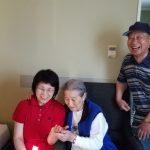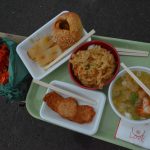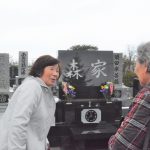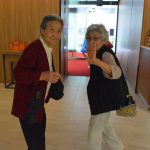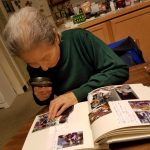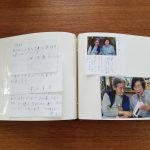31 Jul Traveling to Japan with my mom, who has dementia
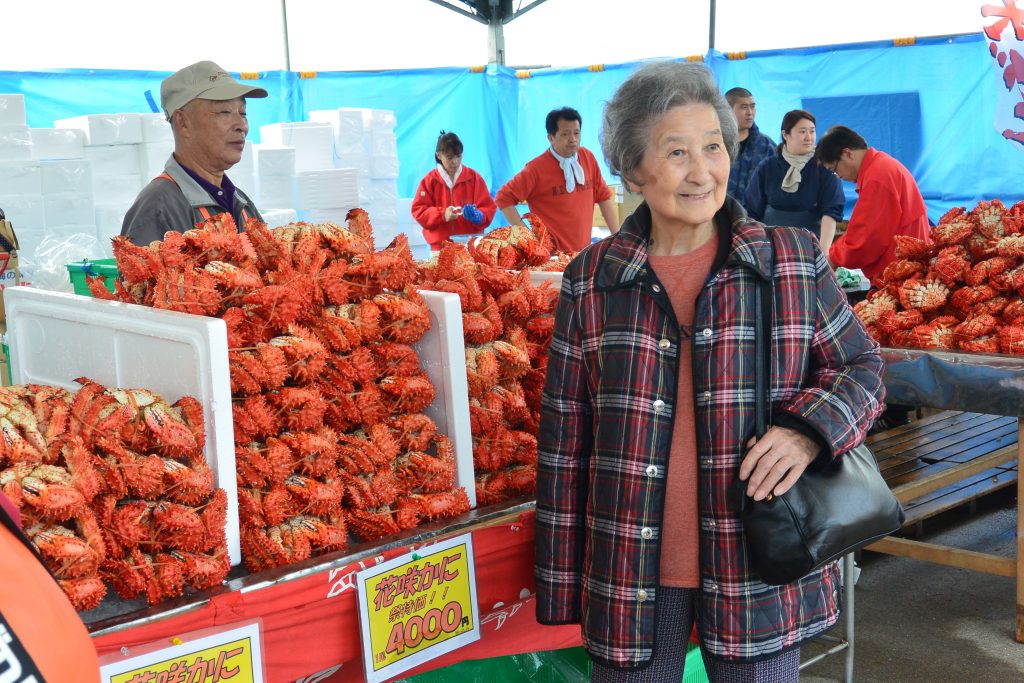
My mom has suffered from worsening dementia for years, and when my brothers and I saw increasing signs that she is no longer able to live by herself we moved her into a Memory Care Center nearby.
Two years ago, my wife Erin and I took the last of several trips to Japan with my mom.
She has a brother in Sapporo, and another brother who lived in Nemuro, her hometown in eastern Hokkaido, until he passed away in January of 2016. His widow, my aunt, still lives in the small fishing town. And in Tokyo, my mom has a distant cousin of my dad, Mrs. Yanagi, who has been her closest friend in Japan for many decades. My older brother and I played with Mrs. Yanagi’s kids, daughter Hiroko and son Atsushi, when we lived in Japan, and I’ve stayed in touch with Hiroko over the years.
When we planned this final trip, we told my mom it’s a “goodbye” trip to Japan because she wouldn’t be able to travel overseas anymore. The first time we went, she showed some signs of her deteriorating dementia, and couldn’t remember some things. The next time, we all stayed in the same hotel room so she couldn’t wander out in the halls on her own (or god forbid, the streets of Tokyo or other cities we traveled in).
So this was her “farewell tour” to say her goodbyes to family and friends. We couched it as a chance to visit her hometown to see her brother Kazuya’s remains in the Buddhist temple, but said it would be the last time she’d see Nemuro or the rest of Japan.
She didn’t quite get the concept. “Hah? I always tell everybody ‘bye bye’ when we come home, but we go back again next year, neh?”
Uh, no, we told her.
This would have to be the last time. Although physically she’s surprisingly healthy (she’s only 84 now), her mental capacity was diminished to the point where she couldn’t remember where we’d been or who we’d visited the night before. But we felt it was important for mom to go back to Japan one more time – after my dad died, she’d been quite a few times, always with me or my younger brother and his family, and one time with her granddaughter when she graduated from high school. She still expected to keep traveling to Japan every year, or every other year.
Because of her OCD tendencies, her trips over the Pacific always followed the same pattern. We would fly to Tokyo then transfer immediately to a flight to Chitose Airport south of Sapporo, which makes for a long day of flying. Then there would be an hour-plus train ride to Sapporo.
- My Aunt Mitsuko, Mom and Uncle Fumiya in Sapporo.
- Here’s just a sample of the ways the local crab, Hanasaki Kani, was cooked up for Kani Matsuri, or Crab Festival in my mom’s hometown of Nemuro.
- There were lots of vendors selling fresh crab.
- This guy was grilling crab for festival goers.
- My Aunt Eiko always treats us to a feast of Hanasaki Kani when we first arrive in Nemuro, my mom’s hometown. This trip was no exception, even though my Uncle Kazuya had passed away.
- Aunt Eiko and my mom at the Mori family memorial at the Nemuro town cemetery. We clean off the gravesite before offering our prayers to the departed.
- My mom and her oldest, closest friend, Mrs. Yanagi, before they take off for a day together.
- My mom after our return, looking through the album of photos and messages from her “Goodbye Trip” to Japan.
- One of the pages in the album, with photos of my Aunt Eiko, and messages from my mom’s friends that we mounted.
We almost always stayed at the same hotel several blocks walk from the Sapporo train station. After two days max in Sapporo where we’d have a couple of meals with her brother Fumiya and his wife Mitsuko, we’d trudge back to the train station and take a day-long ride to eastern Hokkaido, transferring once to a much smaller (one car) train on a narrow, toy-like track for the last several hours until we arrived in Nemuro. We usually stayed in the same hotel there too.
This year, instead of going in late fall (to catch the changing leaves and persimmon, or kaki, season) we went at the end of August so we could enjoy Nemuro’s famous annual “Kani Matsuri,” or “Crab Festival.” Nemuro and the southeast region of Hokkaido boasts a lot of “bests” including salmon, seaweed and Hanasaki Kani, a type of spiny crab that is wonderfully sweet and uniquely delicious. My mom had tantalized us for years with stories about the Crab Festival and kept insisting we had to go the first weekend in September to enjoy it. Once we got there, she seemed to know nothing about it, although it had been going on for decades. She said she never told us to go to it. But we had a great time, watching local and national performers, and eating the local crab cooked up all manner of different ways in every form imaginable, from grilled and steamed to fish cakes, omelets and soup.
On previous trips, after a couple of days in Nemuro, visiting with her brother Kazuya, a lifelong employee of the Nemuro city government, and his wife Eiko, we’d take a two-hour bus ride to Nakashibetsu, a town with a regional airport, to fly down to Tokyo.
We’d spend several days in Tokyo, and mostly visit with Mrs. Yanagi (Mr. Yanagi had died years ago of Alzheimer’s) and Hiroko and her husband Tsuyoshi, and her brother Atsushi. That was pretty much the basic Japan trip as far as my mom was concerned. We added on extra legs like a trip south to Hiroshima and Kyoto on one trip, and a leg west to Denver’s sister city Takayama on another trip. My mom put up with the extra travel only because she got to do her usual circuit first.
For this final trip to Japan, Erin came up with a great idea that I recommend to anyone who is a family caregiver traveling with a dementia or Alzheimer’s patient. Document the trip as you go, so your loved one can re-live the experience anytime.
We bought a small sketchbook, some tape, a nice pen and a Polaroid digital camera. There are several digital cameras now available that produce or print photos on the spot, as well as portable printers that can pop out a photograph from your regular digital camera.
Everywhere we went, we took photographs of my mom with family and friends, and printed them out right on the spot.
We immediately taped the images in a small sketchbook and had my mom write a caption for each photo that stated the date of the picture, who is in it, where it was taken and what we’re doing.
She resisted at first and only wrote in the sketch book reluctantly. But wherever we went, her friends and family ooohed and aaahed over the book and began writing their own messages to my mom, because they could all tell, and understood, that this visit would be my mom’s last. Soon, my mom came around, and got into writing more complete notes.
When we returned to Colorado, my mom didn’t believe me that we had just gone to Japan together. Within a few days we mounted the pages of the sketchbook into a proper photo album/scrapbook and also added other photos that I had taken with my “real” cameras.
She still doesn’t remember the trip, but we brought the photo album to her room at the Landmark Memory Care Center, and she seems to experience her final Japan trip as if she were seeing the images for the first time, and enjoys reading the messages to her. She recognizes her Japanese handwriting, so she pores over the pages carefully.
We ask her on each photo, who’s in it and what’s going on. She also reads out loud and translates the messages from friends and family (even though she doesn’t always remember everyone). We ask her to name everyone in the photos including herself, which she laughs at. If she doesn’t recognize someone, we point out the name where she wrote it under the photo. It’s all to jog her brain a bit and keep her memories of Japan active.
She marvels at her white hair in the photos (“no, that is not me — my hair not so white”), and some long-recessed memories have surfaced.
She saw a woman in a photo I took of my mom at a Nemuro restaurant having dinner with a group of childhood friends, and after recalling her name, my mom gave a passionate and detailed description of the friend’s house, just a few doors down from my grandmother’s house. That night in Japan after my mom had dinner, she couldn’t remember her friend. But now the memories flood back, triggered by something in the small still image.
It’s a cliché, but one picture truly can be worth a thousand words.
I guess if there’s a blessing in dementia, it’s that for my mom, everything old is new again.
This post originally ran as a column in the JACL’s Pacific Citizen newspaper and website. I’m a columnist and the Editorial Board Chair for the P.C.




